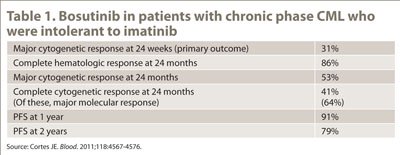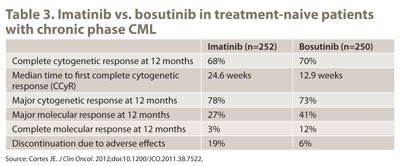Bosutinib: Another option for the treatment of CML
There are three tyrosine kinase inhibitors available for the treatment of chronic myeloid leukemia, but some patients cannot tolerate the side effects.
Others have disease that is resistant to these TKIs.
Bosutinib (Bosulif, Pfizer) — recently approved for the treatment of CML — is an inhibitor of Bcr-Abl and the Src family kinases. It has demonstrated activity against many Bcr-Abl mutations, but not the T3151 or V299L mutations.
Phase 1/2 trials
In a study published in Blood in 2011, Cortes and colleagues evaluated the use of bosutinib in the treatment of patients with chronic phase CML who were intolerant of imatinib (Gleevec, Novartis) or whose disease was resistant to imatinib.
There were 288 patients enrolled in this phase 1/2 study. About one-third of the patients were intolerant of imatinib and about two-thirds of patients were resistant to imatinib.

The first part of this study was a dose-escalation study, and the starting dose for the second part was 500 mg orally daily. Results of this single-arm study are shown in Table 1. The most common treatment-emergent side effects noted during this trial were diarrhea, nausea, rash and vomiting. Anemia, thrombocytopenia, neutropenia and liver function test abnormalities also were noted. The most common grade 3 or 4 toxicities were thrombocytopenia and neutropenia.
The researchers concluded that treatment with bosutinib is effective and tolerable for CML patients who are intolerant or resistant to imatinib. The results of this study are roughly comparable to that seen with nilotinib (Tasigna, Novartis) and dasatinib (Sprycel, Bristol-Myers Squibb) in similar clinical situations, the researchers said.
The same group of researchers published the results of a similar study that involved patients with chronic phase CML who were intolerant or resistant to imatinib, as well as to either nilotinib, dasatinib or both. The analysis included 118 patients. Results from this study, after a median follow-up of 28 months, are shown in Table 2. In this trial, the most common treatment-emergent side effects were diarrhea, nausea, vomiting and rash. Other adverse events included anemia, thrombocytopenia, neutropenia and elevated liver function tests.

The researchers concluded that bosutinib is a new treatment option for patients with CML who are intolerant or resistant to more than one TKI.
Phase 3 trial
Results of a phase 3 trial conducted by Cortes and colleagues appeared earlier this year in the Journal of Clinical Oncology.
The study compared bosutinib with imatinib in treatment-naive patients with chronic phase CML. The open-label study enrolled 502 patients. Those in the study arm received bosutinib 500 mg orally daily, and those in the control arm received imatinib 400 mg orally daily.
The median duration on treatment was 13.8 months. The rate of complete cytogenetic response at 12 months served as the primary outcome. The results of this trial are shown in Table 3.

The side effect profile differed between the two groups. Patients treated with bosutinib experienced more frequent diarrhea, vomiting, abdominal pain and elevations of liver function tests. Patients treated with imatinib experienced more frequent edema, bone pain and muscle spasms.
The incidence of neutropenia was higher in patients assigned to imatinib, but the rates of anemia and thrombocytopenia were similar between the two study arms. The incidence of serious (grade 3 or 4) adverse effects was higher with bosutinib than with imatinib (64% vs. 48%).
The authors concluded that, although treatment with bosutinib was not superior to imatinib in the primary outcome measure, bosutinib therapy offered other benefits. The adverse effects differed between the two treatments, and more patients assigned to bosutinib discontinued treatment due to adverse effects.
Pharmacokinetics
Administration of bosutinib with food both increased the Cmax of bosutinib, but also decreased adverse effects in a pharmacokinetic study. The absorption is fairly slow, with a tmax of about 6 hours. The mean volume of distribution was very large, at more than 6,000 L.
Bosutinib is metabolized primarily by CYP3A4 to inactive metabolites. The mean half-life was 22.5 hours. Most of the bosutinib is eliminated through the feces, and very little appears in the urine. In patients with hepatic impairment, the Cmax and the area under the curve (AUC) both increased 1.5- to 2.5-fold.
Because bosutinib is metabolized through CYP3A4, it is expected that strong inhibitors and inducers of CYP3A4 would alter the pharmacokinetics. Ketoconazole, a model CYP3A4 inhibitor, dramatically increased the Cmax and AUC of bosutinib. Rifampin, a model CYP3A4 inducer, likewise substantially decreased bosutinib’s Cmax and AUC.
Dosing and administration
The recommended starting dose of bosutinib is 500 mg orally once daily. It should be taken with food.
A dosage increase to 600 mg daily may be considered if the patient does not achieve a complete hematologic response by 12 weeks of therapy.
As medications that are strong CYP3A4 inhibitors or inducers dramatically change the Cmax and AUC of bosutinib, concomitant therapy is not recommended; no specific dosage adjustments are recommended for these situations. In patients with mild to severe hepatic impairment, the recommended starting dose of bosutinib is 200 mg orally daily. Dosing adjustments are recommended for patients with elevated liver transaminases, grade-3 or grade-4 diarrhea and myelosuppression.
Adverse effects
The most common side effects (>30%) were diarrhea, nausea, abdominal pain, vomiting and thrombocytopenia. Less common adverse effects (10% to 30%) were anemia, neutropenia, fatigue, fever, edema, asthenia, respiratory tract infection, increased liver function tests, anorexia, arthralgia, back pain, headache and cough.
The most commonly reported grade-3 or grade-4 toxicities were thrombocytopenia, anemia and neutropenia.
Of note, no significant prolongation of the QTc interval was found during specific studies with bosutinib alone or in combination with ketoconazole.
Conclusion
Bosutinib is another TKI for the treatment of CML. It is active against most mutated Bcr-Abl forms, but not the T315I or V229L mutation. Bosutinib has a comparable rate of complete cytogenetic response in treatment-naive CML patients as imatinib. Bosutinib has manageable toxicities that exhibit a slightly different profile than other Bcr-Abl TKIs.
References:
Bosulif [package insert]. New York, NY: Pfizer Inc.; 2012.
Cortes JE. Blood. 2011;118:4567-4576.
Cortes JE. J Clin Oncol. 2012;doi:10.1200/JCO.2011.38.7522.
Khoury HJ. Blood. 2012;119:3403-3412.
Quintas-Cardama A. Drugs Today (Barc). 2012;48:177-188.
For more information:
Lisa K. Lohr, PharmD, BCPS, BCOP, is a clinical pharmacy specialist and oncology medication therapy management provider at the University of Minnesota Physicians Cancer Care at Fairview in Minneapolis. She also is a HemOnc Today Editorial Board member. She may be reached at the University of Minnesota Physicians Cancer Care at Fairview, 424 Harvard St. SE (MMC 114), Minneapolis, MN 55455.
Disclosure: Lohr reports no relevant financial disclosures.
